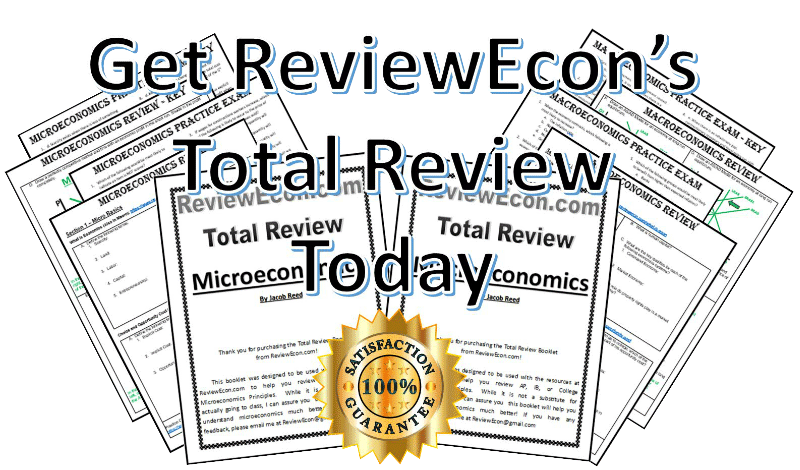Macroeconomics Complete Study Guide
Updated: 6/1/2020 Jacob Reed
Below you will find resources covering all major aspects of Macroeconomics. I send my students these games, videos, and content review at the end of each unit to help them prepare for their unit exams. My students also use these to review and prepare right before AP Macroeconomics exam in May. I sincerely hope these resources help you as much as they have my students.

If there are resources you think should be added to this list, click on the contact link below and send me a message. Good luck!
Not sure what to study First?
Start with the Macroeconomics 30 Multiple Choice Exam to see where you struggle or practice your macroeconomics graph labels!
From Microeconomics
You must understand the basics of scarcity and opportunity cost along with supply and demand. You should also fully understand the Production Possibilities curve and comparative advantage.
Review: Scarcity and Opportunity Cost, Production Possibilities Curve, Determinants of Supply and Demand, Shifting Supply and Demand, Comparative Advantage,
Game: Cost, Profit, and Revenue Activity (opportunity cost), Production Possibilities Curve Activity (PPC), Sorting Determinants Activity (Determinants), Changes in Supply and Demand, Shifting Competitive Markets Activity (Market Shifts), Comparative Advantage Activity (Comparative ADV)
Graph Drawing Practice: Production Possibilities Curve
Outside video: Paddy Hirsch Video (Opportunity Cost), 1funkyTeacher (PPC), ACDC Video (Supply and Demand), Marginal Revolution University Video (Comparative Advantage)
Macro Basics
Flashcards For Macro Basics
Macro Basics Multiple Choice
*Macroeconomic Goals: Know the different parts of the business cycle and understand the 3 macroeconomic goals of stable prices, full employment, and growth.
Review: Economic Goals and the Business Cycle
Game: Business Cycle
Outside Video: Crash Course Economics
*Circular Flow Diagram: Know the flows, actors, and markets.
Review: Circular Flow Diagram Review
Game: Circular Flow Diagram Review Game
Outside Video: ACDC Video
*Gross Domestic Product: Be able to explain all parts of the output-expenditure formula for GDP and identify what is and is not included in GDP. Understand why GDP is an imperfect measure of standard of living and how it may over or understate a country’s true standard of living.
Review: Gross Domestic Product
Game: GDP Component Identification
Outside Video: St. Louis Fed
*Inflation: Understand the difference between real and nominal values as well as how to calculate them (see the formulas cheat sheet). Pay special attention to real vs. nominal GDP as well as the CPI.
Review: GDP Deflator and CPI, Fisher Formula
Games: Deflator and CPI calculations, Real and Nominal Rates
Outside Video: ThinkWellVids, ExamPop
Review: Unemployment and NRU
Outside Video: mjmfoodie (definition of unemployment), mjmfoodie (types of unemployment)
AS/AD and Fiscal Policy
Flashcards for AS/AD and Fiscal Policy
AS/AD & Fiscal Policy Multiple Choice Practice
*AS/AD Model: Be able to draw, analyze and manipulate the AS/AD graph. Know how to illustrate inflationary and recessionary gaps. Understand the difference between AS and LRAS and know what shifts the curves. Be able to describe how the economy will readjust to long-run equilibrium without government intervention. Understand how monetary (from unit 3) and fiscal policy as well as demand and supply shocks impact the AS/AD model.
Review: AS/AD Model Graph
Games: AD, SRAS, and LRAS Shifts Game, AS/AD Model Activity
Graph Drawing Practice: AS/AD Model
Outside Video: mjfoodie (intro to AS/AD), ACDC (AS/AD and LRAS)
*Marginal Propensity to Consume/Save and Fiscal Policy Multipliers: Understand the difference between average and marginal propensities and be able to calculate each of them. Understand the process by which a change in consumption, investment, government spending or taxes will impact real GDP. Be able to calculate the spending and tax multipliers and maximum changes to GDP.
Review: Marginal Propensities to Consume and Save
Game: Propensities and Multipliers
Outside Video: ACDC
*Loanable Funds Market: Be able to draw, analyze, and manipulate the loanable funds graph. Understand what shifts each curve and how the equilibrium real interest rate impacts gross investment. Understand how government taxes and spending impact the market and how deficits can crowd out investment.
Review: Loanable Funds Market
Game: Shifting Loanable Funds
Graph Drawing Practice: Loanable Funds
Outside Video: Phil Klein
*Fiscal Policy: Understand how increases and/or decreases in taxes and/or spending impact the overall economy. Be able to show how fiscal policy impacts AS/AD, Loanable funds, and the growth rate.
Review: Fiscal Policy Tools, Deficits and Crowding Out
Games: Fiscal/Monetary Policy Sorting, Shifting Loanable Funds, AS/AD Model Activity
Outside Video: Crash Course, ACDC
Review: Phillips Curve
Game: Phillips Curve
Graph Drawing Practice: Phillips Curve
Outside Video: ACDC
Monetary Policy
Flashcards for Monetary Policy
Monetary Policy Multiple Choice Practice
*Money: Know the functions of money and the the measurements of the money supply
Review: What is Money?
Outside Videos: ACDC (functions of money), Khan Academy (money supply measuring)
*Quantity Theory Of Money: Know the monetary equation of exchange and be able to use it to calculate changes in each of the variables and nominal GDP.
Review: MV=PQ
Game: Monetary Equation of Exchange Calculations
Outside Videos: Marginal Revolution University (Quantity Theory of Money)
*Bank Balance Sheets: Know the different components of a bank balance sheet and what each of the components contains. Understand how events can change a bank’s balance sheet and in turn the bank’s ability to make loans and create money.
Review: Bank Balance Sheets
Game: Bank Balance Sheet Manipulation Activity
Outside Video: No Bull Economics Lessons
*Monetary Policy Tools: Understand how expansionary and contractionary monetary policy can be used to impact the overall economy and close output gaps. Know what open market operations are. Be able to show how monetary policy impacts the money market, and AS/AD model. Understand how changes in the money supply are multiplied through the banking system.
Review: Monetary Policy
Game: Monetary Sorting, Money Multiplier Calculations
Outside Video: Jason Welker (Monetary Policy, ACDC (Money multiplier)
Review: Money Market
Game: Shifting Money Market
Graph Drawing Practice: Money Market
Outside Video: ACDC
International Markets
Flashcards for Foreign Trade
International Markets Multiple Choice Practice
*Foreign Exchange Markets: Be able to draw, analyze, and manipulate the money market graph. Understand how relative interest rates, price levels, and national income impact the exchange rate.
Review: Foreign Exchange Market
Game: Shifting Foreign Exchange Market
Graph Drawing Practice: Foreign Exchange Market
Outside Video: Jason Welker
*Balance of Payments: Know what goes in the current account as opposed to the financial (capital) account. Understand how the two accounts balance and what causes each to increase or decrease (credit or debit, surplus or deficit). Understand how changes in the macro economy and foreign exchange markets impact the balance of payments including net exports.
Review: Balance of Payments
Game: Current Account and Financial Account
Outside Video: Jason Welker (current account), Jason Welker (financial account), Jason Welker (relationship between accounts)
